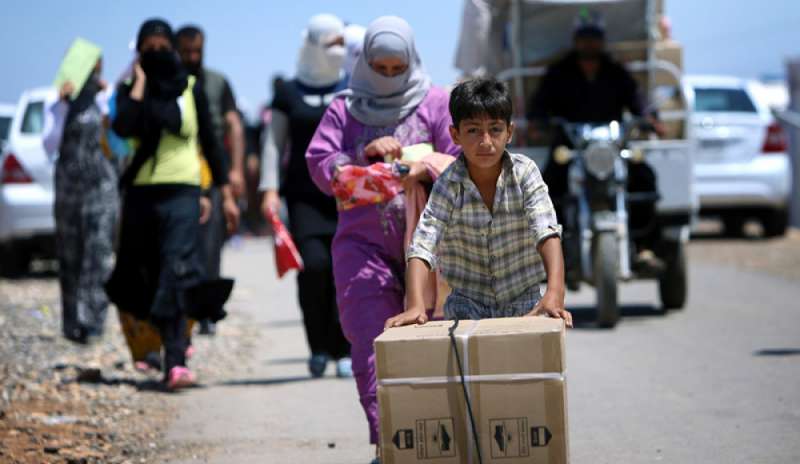
Hamra is tiny and plump. Her green eyes are lit by the sun hiding behind a thin veil of clouds; and her little hands, of a five year old, repeat the quick motions she makes when handling tobacco.
“This is how I would braid the leaves,” she said. “I worked for three days in a row.” It is Tuesday morning, but neither Hamra nor her cousins of 12 and 15 years old are at school. The two older kids are helping the little girl’s father to repair a car. Father Mahmoud is a thirty-year-old man from Qusair, a Syrian town 15 kms from the Lebanese border. About a year ago, as the conflict was about to become too dangerous, he escaped to nearby Lebanon with the kids, his wife and his brother. Now he lives in Baalbek, in Beqaa Valley, in a piece of land owned by a farmer that, in exchange for work, has let him erect the tent inside his property.
Little Hamra doesn’t go to school: “We have to eat,” said her mother to Al Jazeera, “so she was taught how to braid tobacco and now she works with us. I know it’s hard for her, but what can we do?” Nobody can afford to stay away from work, in Beqaa Valley. They are paid two dollars each for every three hours of work: enough to buy a piece of bread and have some money left for moving around the city.
And Hamra’s is only one of thousands of families that live in Lebanon’s suburbs and refugee camps. According to the most recent data provided by UNICEF, there are about 350,000 Syrian kids who don’t attend school, but rather spend their days working; as the huge hidden child labor market continues to expand. And even if she and her brothers and cousins had the time, they wouldn’t be able to go to school anyway: there is no room in the public schools at Baalbek, whereas the private ones are too expensive for their family. This is the situation for most refugees in Lebanon. UNICEF’s Child Protection Officer Abi Khalil explained that, even if all public schools in the country agreed to making afternoon shifts available, there would still be no room for accommodating all the children in need.
“Most of the families living in the Lebanese tent cities are headed by women,” said Abi Khalil. “And these women come from rural, conservative cultures, where they aren’t expected to work. For this reason, it’s their kids that, in most cases, become the only source of income for the entire family.”
Today you can see, in Lebanon, 10 year old children working full time in jobs suitable for grown-ups: they package pampers in factories, stock food products on shelves and deliver food around the city. On the other hand, five-year-old girls such as Hamra braid tobacco that will then be sold to the Lebanese state, which manufactures the national brand cigarettes.
“An adult costs 7 dollars a day, whereas a child something between 3.50 and 4” said Mahmoud. This is the primary reason, why child labor is preferable. “Furthermore, children are more efficient, more energetic and easier to hire without any prior notice.”
The Lebanese government has signed an international treaty that makes employment of children under 15 illegal. Yet, the treaty applies to the regular job market, whereas most of the young Syrians work in the black market. Child labor is a deep wound, which is getting worse around the world, as it grows around the conflicts that seem to feed it. And the young Syrian workers aren’t just in Lebanon: in Turkey, for example, 73% of them work exhausting jobs: thousands of little kids work 12 hours a day. “There are too few labour inspectors, no clear procedures for what to do about child labour,” said Hakan Acar, a university professor, to The Guardian.
The tragic fate of these children is the result of war outcomes that spare no one. Hamra’s and her family’s everyday struggle is a slap in the face for the international community and for those who continue setting the world in fire. And no one knows if she and her cousins will be able to return to school one day.
Translation provided by ProLingua









